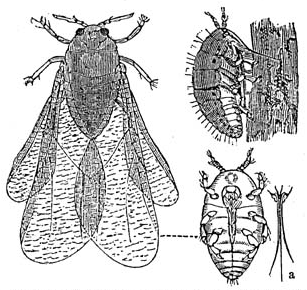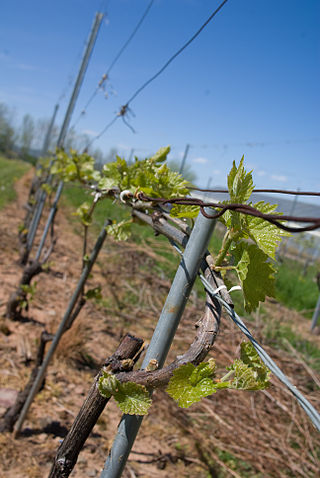
Grape phylloxera is an insect pest of grapevines worldwide, originally native to eastern North America. Grape phylloxera ; originally described in France as Phylloxera vastatrix; equated to the previously described Daktulosphaera vitifoliae, Phylloxera vitifoliae. The insect is commonly just called phylloxera.
Seibel grapes are a group of wine grape varieties which originated with the work of French viticulturist Albert Seibel crossing European grape with American grape species to increase disease resistance. They were planted widely in France during the 1950s but have seen decline in recent years because French wine law prohibits hybrid grapes in appellation wine. The grapes are still commonly used as blending grapes in table wine and mass commercial wines. New Zealand, England, and Canada also have plantings of Seibel grapes.

Chambourcin is a variety of grapevine belonging to the Vitis genus in the flowering plant family Vitaceae. It is a French-American interspecific hybrid grape variety used for making wine. Its parentage is uncertain, but genetic studies show it likely includes several North American Vitis species in its background including: V. berlandieri Planch., V. labrusca L., V. lincecumii Buckley, V. riparia Michx., V. rupestris Scheele, and V. vinifera. The hybrid was produced by Joannes Seyve who often used Seibel hybrids produced in the 1860s. The grape has only been available since 1963; it has a good resistance to fungal disease, and is one of the parents of the new disease resistant variety, Regent, which is increasing in popularity among German grape growers.

In botany, chlorosis is a condition in which leaves produce insufficient chlorophyll. As chlorophyll is responsible for the green color of leaves, chlorotic leaves are pale, yellow, or yellow-white. The affected plant has little or no ability to manufacture carbohydrates through photosynthesis and may die unless the cause of its chlorophyll insufficiency is treated and this may lead to a plant disease called rusts, although some chlorotic plants, such as the albino Arabidopsis thaliana mutant ppi2, are viable if supplied with exogenous sucrose.

Vitis labrusca, the fox grape, is a species of grapevines belonging to the Vitis genus in the flowering plant family Vitaceae. The vines are native to eastern North America and are the source of many grape cultivars, including Catawba, Concord, Delaware, Isabella, Niagara, and many hybrid grape varieties such as Agawam, Alexander and Onaka. Among the characteristics of this vine species in contrast to the European wine grape Vitis vinifera are its "slip-skin" that allows the skin of the grape berries to easily slip off when squeezed, instead of crushing the pulp, and the presence of tendrils on every node of the cane. Another contrast with European vinifera is the characteristic "foxy" musk of V. labrusca, best known to most people through the Concord grape. This musk is not related to the mammalian fox, but rather to the strong, earthy aromas characteristic of the grapes that were known by early European-American settlers in the New World. The term "foxy" became a sort of catchall for the wine tasting descriptors used for these American wines that were distinct from the familiar flavors of the European viniferous wines.

Vitis aestivalis, the summer grape, or pigeon grape is a species of grape native to eastern North America from southern Ontario east to Maine, west to Oklahoma, and south to Florida and Texas. It is a vigorous vine, growing to 10 m or more high in trees. The leaves are 7–20 cm long, suborbicular, and usually a little broader than long; they are variable in shape, from unlobed to deeply three- or five-lobed, green above, and densely hairy below. The flowers are produced at every 3rd node in a dense panicle 5–15 cm long. The fruit is a small grape 5–14 mm diameter, dark purple or black in colour. It is the official state grape of Missouri. Summer grape prefers a drier upland habitat.

Vitis rupestris is a species of grape native to the United States that is known by many common names including July, Coon, sand, sugar, beach, bush, currant, ingar, rock, and mountain grape. It is used for breeding several French-American hybrids as well as many root stocks.

Hybrid grapes are grape varieties that are the product of a crossing of two or more Vitis species. This is in contrast to crossings between grape varieties of the same species, typically Vitis vinifera, the European grapevine. Hybrid grapes are also referred to as inter-species crossings or "Modern Varieties." Due to their often excellent tolerance to powdery mildew, other fungal diseases, nematodes, and phylloxera, hybrid varieties have, to some extent, become a renewed focus for European breeding programs. The recently developed varieties are examples of newer hybrid grape varieties for European viticulturalists. Several North American breeding programs, such as those at Cornell and the University of Minnesota, focus exclusively on hybrid grapes, with active and successful programs, having created hundreds if not thousands of new varieties.

Thomas Volney Munson, often referred to simply as T.V. Munson, was a horticulturist and breeder of grapes in Texas. In 1888, Munson was the second American, after Thomas Edison, to be named a Chevalier du Mérite Agricole by the French government.

Aramon or Aramon noir is a variety of red wine grape grown primarily in Languedoc-Roussillon in southern France. Between the late 19th century and the 1960s, it was France's most grown grape variety, but plantings of Aramon have been in continuous decline since the mid-20th century. Aramon has also been grown in Algeria, Argentina and Chile but nowhere else did it ever reach the popularity it used to have in the south of France.
Couderc noir is a red wine hybrid grape that was formerly grown primarily in the South West France wine region and around the Gard département in the Languedoc-Roussillon region. The vine produces high yields and ripens late, creating a wine that is deeply colored with a distinct, earthy flavor. Couderc noir is normally used for mass commercial and table wines.

The Delaware grape is a cultivar derived from the grape species Vitis labrusca or 'Fox grape' which is used for the table and wine production.

Vitis (grapevine) is a genus of 81 accepted species of vining plants in the flowering plant family Vitaceae. The genus consists of species predominantly from the Northern Hemisphere. It is economically important as the source of grapes, both for direct consumption of the fruit and for fermentation to produce wine. The study and cultivation of grapevines is called viticulture.

Vitis berlandieri is a species of grape native to the southern North America, primarily Texas, New Mexico and Arkansas.
Cascade is a red complex hybrid grape variety that was created by French viticulturist Albert Seibel in the early 20th century in Aubenas, Ardèche, in the Rhône Valley. It has been commercially available in North America since 1938 and has since been planted in Canada and the United States. However, in warmer climates the grape is highly susceptible to a number of grapevine viruses, which has discouraged plantings of the variety.

L'Acadie blanc is a white Canadian wine grape variety that is a hybrid crossing of Cascade and Seyve-Villard 14-287. The grape was created in 1953 by grape breeder Ollie A. Bradt in Niagara, Ontario at the Vineland Horticultural Research Station which is now the Vineland Research and Innovation Centre. Today the grape is widely planted in Nova Scotia with some plantings in Quebec and Ontario. Some wine writers, including those at Appellation America, consider L'Acadie blanc as "Nova Scotia’s equivalent to Chardonnay".

The propagation of grapevines is an important consideration in commercial viticulture and winemaking. Grapevines, most of which belong to the Vitis vinifera family, produce one crop of fruit each growing season with a limited life span for individual vines. While some centenarian old vine examples of grape varieties exist, most grapevines are between the ages of 10 and 30 years. As vineyard owners seek to replant their vines, a number of techniques are available which may include planting a new cutting that has been selected by either clonal or mass (massal) selection. Vines can also be propagated by grafting a new plant vine upon existing rootstock or by layering one of the canes of an existing vine into the ground next to the vine and severing the connection when the new vine develops its own root system.
Landal noir is a red hybrid grape variety that was created during a series of trials between 1929 and 1942 by French grape breeder Pierre Landot at his Conzieu nursery in the Ain department of eastern France. The grape is a crossing of two Seibel grapes, Plantet and Seibel 8216. While authorized for use in several French wine growing region, the grape is officially not recommended for use in any quality wine production in France with only 49 hectares of the variety reported in 2008. Outside France some plantings of Landal noir can be found in Switzerland, Canada and the United States.
The Champanel grape is an American hybrid developed by Thomas Volney Munson of Texas. Champanel is a cross of the two grape varieties Vitis champinii X Worden, a Concord seedling. It grows vigorously, is resistant to root rot, Pierces disease and produces clusters of fruit resistant to rot and mildew. Although well adapted to a wide range of growing conditions, Champanel produces fruit with aroma characteristic of its Concord parentage and is not often seen commercially. Rather, Champanel is most often used as grafting material for Vitis vinifera, to provide disease resistant root stock. Jim Kamas writes, "Although the cause of vine death from [Pierce disease] was not known to him, T.V. Munson realized that utilizing grape parents that survived local conditions was important in creating new, improved adapted grape varieties" (Power). Munson not only developed a hybrid grape that is resistant to Pierce disease but that grows well in any soil type. The Champanel grapevine grows vigorously on any type of trellis it is placed under. The vine can be placed beside a fence so that the arms of the vine can run along it. Even though the vine grows vigorously, the Champanel grapevine is great for first time growers who want to add grapevines to their garden for the berries or for aesthetics. With the berries a grower can make jelly, juice or wine. This vine is excellent for growing up an arbor to provide shade in a growers back or front yard.













